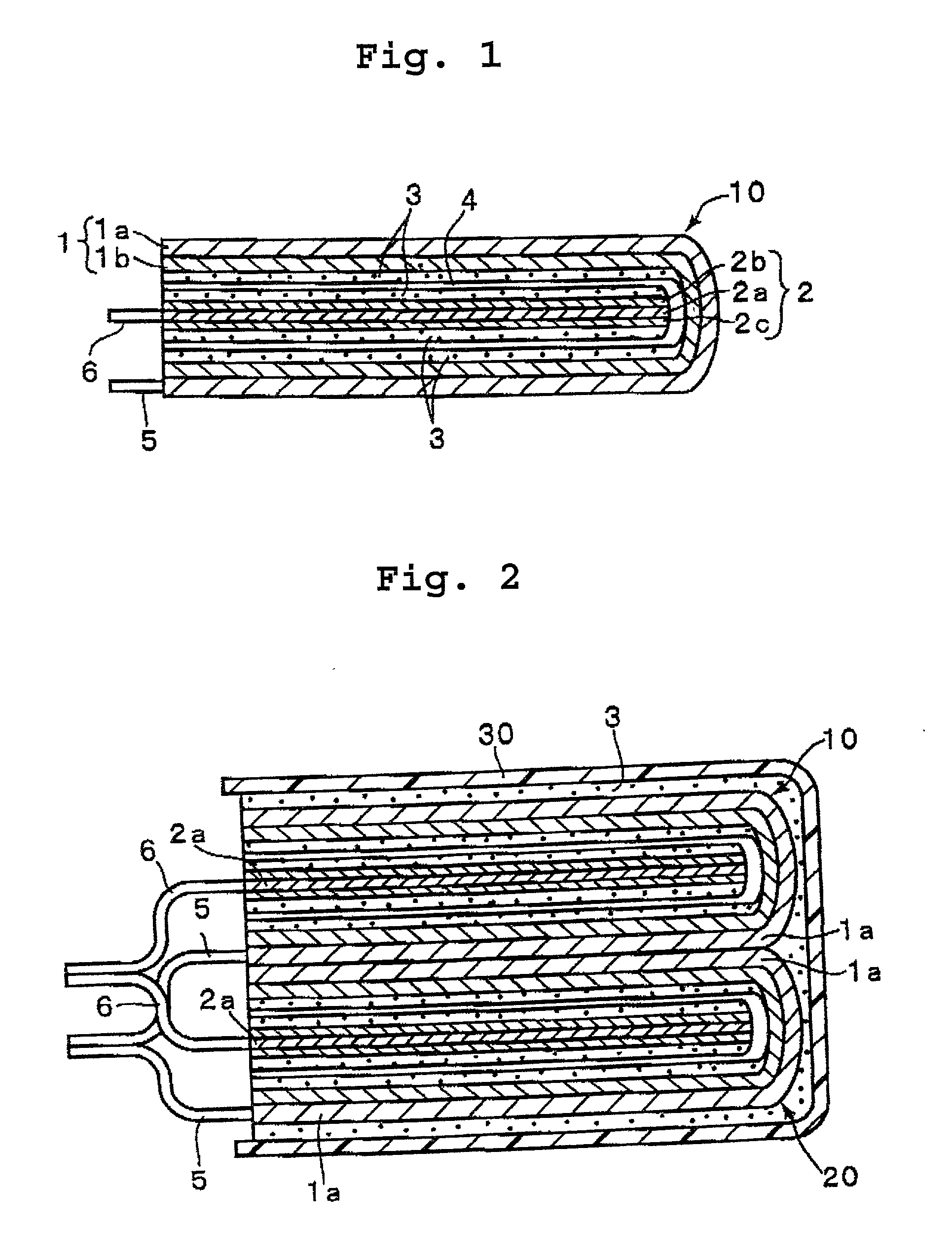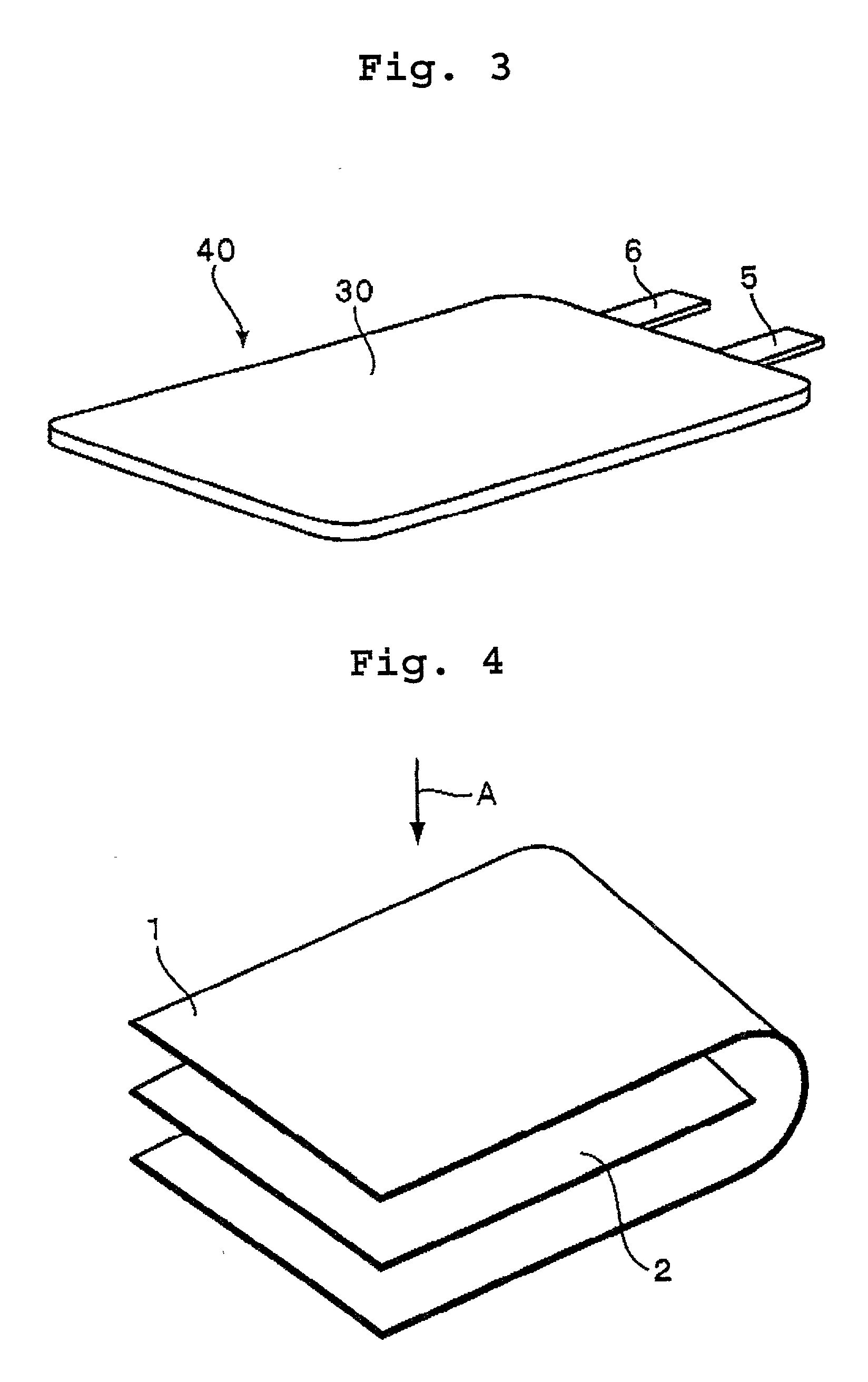Polymer-electrolyte lithium secondary battery
a polymer electrolyte technology, applied in the field of polymer electrolyte, can solve the problems of high battery structural pressure, poor heat radiation, and poor adhesion of polymer electrolyte in a conventional lithium polymer secondary battery, and achieve good cycle characteristics and suitable structure.
- Summary
- Abstract
- Description
- Claims
- Application Information
AI Technical Summary
Benefits of technology
Problems solved by technology
Method used
Image
Examples
experiment 1
[0041] Experiment 1
[0042] The overlapped area of electrodes and thickness of a lithium polymer secondary battery of the present invention were varied to evaluate the effect on cycle characteristics.
[0043] Preparation of Positive Electrode
[0044] 85 weight % of LiCoO.sub.2 powder having average particle diameter of 10 .mu.m, 10 weight % of carbon powder as a conductive agent and 5 weight % of polyfluorovinylidene powder as an binding agent were mixed, and N-methylpyrrolidone was mixed to prepare a slurry. The slurry was coated on both sides of an aluminum electrode collector having a thickness of 20 .mu.m by a doctorblade method. Thicknesses of the coatings are about 60 .mu.m and about 75 .mu.m. The coated electrode collector were dried at 120.degree. C., and cut to a predetermined size to prepare positive electrodes.
[0045] Preparation of Negative Electrode
[0046] 95 weight % of natural graphite having an average particle diameter of 20 .mu.m and 5 weight % of polyfluorovinylidene powd...
experiment 2
[0065] Experiment 2
[0066] Effects of different polymer electrolytes with respect to cycle characteristics were studied.
[0067] Preparation 1 of Polymer Electrolyte
[0068] Polyfluorovinylidene (molecular weight 300,000) was dissolved in acetone, and was poured on a Teflon sheet and was dried to prepare a polymer film having a thickness of 100 .mu.m. LiPF.sub.6 was dissolved into a mixture of ethylene carbonate and diethyl carbonate (1:1) to prepare an electrolyte of 1 mol / l LiPF.sub.6. The electrolyte penetrated the polymer film until it became saturated to prepare a gel polymer electrolyte.
[0069] Preparation 2 of Polymer Electrolyte
[0070] Copolymer oligomer (molecular weight 700) of 1:1 of acrylonitrile and styrene was added to the electrolyte of LiPF.sub.6 dissolved into a mixture of ethylene carbonate and diethyl carbonate (1:1) in an amount of 1 mol / l LiPF.sub.6, and was dissolved to provide a weight ratio of 5:1. An initiator, t-butyl peroxyoctoate was added in an amount of 5000 p...
experiment 3
[0077] Experiment 3
[0078] Various heterocyclic compounds were added to a polymer electrolyte to evaluate the effect on cycle characteristics.
[0079] Preparation of Polymerization Solution for Polymer Electrolyte
[0080] 1,3-propanesulfone, sulfolane, butadiene sulfone, vinylene carbonate, isoxazole, N-methyl morpholine or N-methyl-2-pyrrolidone was added to the polymerization solution for the polymer electrolyte prepared in Experiment 1 in an amount of 1 weight % to prepare a polymerization solution.
[0081] Preparation of Lithium Polymer Secondary Battery
[0082] Lithium polymer secondary batteries F1-F7 were prepared in the same manner as battery B3 in Experiment 1 except that the polymerization solution prepared above was used. The additive in the polymerization solution for each battery is shown in Table 4. The result of battery B3 is also shown in Table 4.
4TABLE 4 Cycle Characteristics Battery Additive (%) F1 1,3-Propanesultone 82 F2 Sulfolane 82 F3 Butadiene sulfone 86 F4 Vinylene ca...
PUM
| Property | Measurement | Unit |
|---|---|---|
| thickness | aaaaa | aaaaa |
| temperature | aaaaa | aaaaa |
| particle diameter | aaaaa | aaaaa |
Abstract
Description
Claims
Application Information
 Login to View More
Login to View More - R&D
- Intellectual Property
- Life Sciences
- Materials
- Tech Scout
- Unparalleled Data Quality
- Higher Quality Content
- 60% Fewer Hallucinations
Browse by: Latest US Patents, China's latest patents, Technical Efficacy Thesaurus, Application Domain, Technology Topic, Popular Technical Reports.
© 2025 PatSnap. All rights reserved.Legal|Privacy policy|Modern Slavery Act Transparency Statement|Sitemap|About US| Contact US: help@patsnap.com



